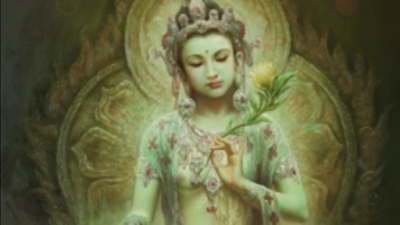 |
| If Mara the Tempter, Death, comes upon you, recognize him and he has no power. |
There aren't many Guarnieris in the U.S., so few that we all know each other and are probably directly related as we hail from the same part of the Old World in Italy.
 She then became a real estate mogul on the opposite coast. But today is her birthday, and she's still famiglia.
She then became a real estate mogul on the opposite coast. But today is her birthday, and she's still famiglia.
It got us to thinking, as National Women's Day and the pending Women's March, how did she go from uber liberal to Marine mom and Trump supporter. But it has made her rich, an entrepreneur, a Gold Coast citizen who hob knobs with the suburbanites and suffers along with all of us in a tanking economy. By the way, buy ShapeWay.
 But as she gets older, we worry about her spiritual life. She's gone Christian, not pedestrian Simpsons' style Presbyterianism but something more worrisome. Not like Mom, who went off the rails long ago. There must be one or more sutras apropos of which she could still gain freedom here and now! Bhikkhu Bodhi?
But as she gets older, we worry about her spiritual life. She's gone Christian, not pedestrian Simpsons' style Presbyterianism but something more worrisome. Not like Mom, who went off the rails long ago. There must be one or more sutras apropos of which she could still gain freedom here and now! Bhikkhu Bodhi?
Discourses of the Ancient Nuns
Bhikkhu Bodhi (aka Jeffrey Block) Bhikkhuni-Samyutta edited by Wisdom Quarterly
 |
| Avalokiteshvara evolves into Kwan Yin |
The growing interest in women's spirituality has led to a renewed focus upon the Therigatha, the "Verses of the Elder Nuns," as the oldest existing testament to the feminine experience of Buddhism.
Despite this recent attention to the Therigatha, however, it seems that all but a few scholarly commentators have overlooked a short chapter in the Samyutta Nikaya that serves as an important supplement to the larger work.
This is the Bhikkhuni-Samyutta, Chapter 5 of the Sagathavagga-Samyutta, the "Connected Discourses with Verses," Volume I of the Samyutta Nikaya.
The Bhikkhuni-Samyutta is a compilation of ten short sutras in mixed prose and verse, with a total of 37 verses. Though several of these verses have parallels in the Therigatha (mentioned in the notes), a significant number do not, and often the variations in roughly parallel versions are themselves of intrinsic interest.
At least one nun in the Bhikkhuni-Samyutta, Ven. Vajira, does not appear in the Therigatha, while the case of another nun, Ven. Sela, is problematic.
A comparison between the two collections also brings to light some noteworthy differences in the ascription of authorship; in one case -- that of the three Cala sisters -- a three-way shuffling of ascriptions occurs.
A comparison between the two collections also brings to light some noteworthy differences in the ascription of authorship; in one case -- that of the three Cala sisters -- a three-way shuffling of ascriptions occurs.
Such differences can be readily understood once we realize that the texts were originally transmitted orally for several centuries and thus were contingent on less durable factors than paper and ink.
Since the Samyutta Nikaya and the Therigatha were evidently transmitted by different lines of reciters, it was only too easy for verses to break off from their original narrative setting and merge with a different background story connecting them to a different author.
Since the Samyutta Nikaya and the Therigatha were evidently transmitted by different lines of reciters, it was only too easy for verses to break off from their original narrative setting and merge with a different background story connecting them to a different author.
The antiquity of this collection is attested to by the fact that it has a counterpart in the Chinese translation of the Sanskrit Samyukta-Agama, which probably belonged to the Sarvastivada school.
 |
| The Buddha on women, nuns, female enlightenment (Buddhism.about.com) |
.
Anesaki's The Four Buddhist Agamas in Chinese gives a breakdown of the Chinese equivalent of the Bhikkhuni-Samyutta, and though the order of sutras is different, the ten titles are almost identical, except that the Pali Sela Sutra is there entitled Viri (or Vira).
This is strong evidence that the entire chapter had taken shape before the Pali and Sarvastivada schools went their separate ways.
All the ten sutras are constructed according to the same pattern, a direct confrontation between Mara the Evil One [more Cupid than Satan], the God of Sensuality, and an individual nun. This structure perhaps accounts for the placement of the Bhikkhuni-Samyutta immediately after the Mara-Samyutta, in which the Evil One is shown trying to distract the Buddha and the monastics.
In each sutra of our collection a nun goes off by herself to pass the day in secluded solitary meditation. Then Mara approaches her with a challenge -- a provocative question or a taunt -- intending to make her fall away from concentration.
 |
| Whoa, it's as if Bowie's fan fell to Earth, too! |
What Mara has failed to realize is that each of these nuns is an arhat [fully enlightened] and has seen so deeply into the truth of the Dharma that she is utterly inaccessible to his wiles. Far from being flustered by Mara's challenge, the nun promptly deduces the identity of her adversary and overturns his challenge with a sharp reply.
Once Mara realizes that his number has been called he has no choice but to vanish on the spot, "sad and disappointed." More
Good luck, Gina.


































































































































































































































No comments:
Post a Comment